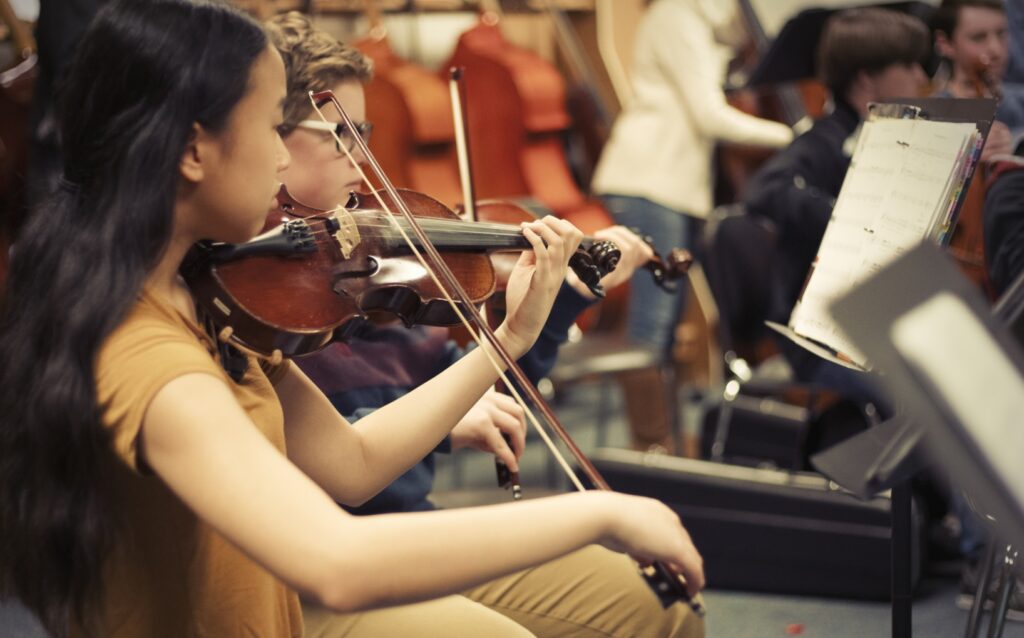Best Practices for Online Rehearsals
As schools continue virtual learning during the pandemic, restructure your ensemble practices to help students stay engaged.
And there it was … the email that said we were limited to online-only rehearsals for summer band camp. With COVID-19 numbers rising locally and our governor restricting mass gatherings, putting hundreds of band members in a room together would not be possible.
The news did not deter me. I am a tech nerd. I could figure this out. I scoured the internet for the most efficient and engaging ways to rehearse remotely. I found many helpful hints, but nothing prepared me for that first rehearsal. It was so quiet. A student was eating Taco Bell. Everyone was texting on their phones.
I needed to reevaluate how this rehearsal would run. My students were in their most comfortable spaces … their bedrooms or other places in their homes. How was I going to get them in the same mindset that they would be in the band room?
I had to figure out more than just software settings. Here are some ways that I overcame the pitfalls of remote rehearsing.
Learn the Software
Virtual meeting tools like Zoom, Microsoft Teams, Webex and Google Meet allow teachers to connect with their students in real time even while socially distanced. When deciding on software, consider participant and meeting length restrictions. I recommend a Zoom account, currently free for teacher use with up to 100 participants and no time limits.
Most web conferencing platforms offer chat, screen sharing, recording and mute/unmute features. Become familiar with the options and create a tutorial document or video for your students. Include a meeting password to preserve privacy.
Maintain and Adapt Instructions
When you meet with your ensemble online, routines must be set up like they would be in your classroom. Students should choose well-lit and distraction-free spaces, away from younger siblings and pets.
Because they are at home, students might feel more casual about their posture and embouchure. Students should set up their cameras at a distance, so you can see their techniques.
Remind students to follow normal rehearsal protocol, including no cell phone use, eating or leaving without permission. Within a week of reinforcing these guidelines, I started to see progress.
When using any video messaging application, a slight delay occurs as the video and sound travel over the internet, making unified playing nearly impossible. Consequently, you must mute all students and teach more visually. Use the software’s spotlight feature, which allows you to see one student in full screen mode, so you get an eye on posture, embouchure, fingerings and bowing or percussion sticking techniques.
Hold Sectionals in Breakout Rooms
Some programs offer breakout rooms, so you can split up your ensemble manually into sections or peer mentor groups as well as randomly for icebreakers and team-building exercises. While other online platforms may not have the same feature, you can create multiple section-specific meetings that occur at the same time.
I ask my section leaders, first chair players or more experienced students to lead sectionals. Before the rehearsals, I meet with the leaders to brainstorm lesson plans that cover specific passages and techniques. They need a clear vision for rehearsals, so that they feel empowered, prepared and organized.
As the meeting moderator, you can move from room to room, listening to passages and giving bursts of feedback. When jumping between rooms, ask the student leaders how they are progressing through their planned lessons and offer quick tips to keep their rehearsals moving.
When your leaders run their groups, they may become frustrated. Follow up with them after rehearsals to reflect on difficulties. You will feel more appreciation from your student leaders since they have put themselves in your shoes.
Make Use of Chat Features
With the chat feature, you can give feedback to the students privately or publicly, and the students can ask questions while you are lecturing or demonstrating. I recommend eliminating student-to-student chat in the settings to avoid distraction.
Try this: Tell your students to play a passage, one person at a time. Type the corrections into a private chat, so the student can review areas of improvement while you listen to the next person.
Though online classrooms may never replace the electric feeling we get while performing in a live ensemble, we can provide our students with lightbulb moments and feelings of success.
 This article originally appeared in the 2020N3 issue of Yamaha SupportED. To see more back issues, find out about Yamaha resources for music educators, or sign up to be notified when the next issue is available, click here.
This article originally appeared in the 2020N3 issue of Yamaha SupportED. To see more back issues, find out about Yamaha resources for music educators, or sign up to be notified when the next issue is available, click here.















